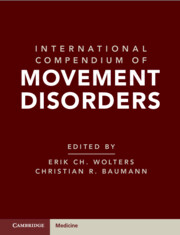Book contents
- International Compendium of Movement Disorders
- International Compendium of Movement Disorders
- Copyright page
- Contents
- Contributors
- International Compendium of Movement Disorders
- Hypo- and Hyperkinetic, Dyscoordinative and Otherwise Inappropriate Motor and Behavioral Movement Disorders
- Section 1: Basic Introduction
- Chapter 1 Behavior
- Chapter 2 The Basal Ganglia
- Chapter 3 The Role of the Cerebellum
- Chapter 4 Neuropathological Overview of Neurodegenerative Disorders
- Chapter 5 Genetic Models of Movement Disorders
- Chapter 6 Mitochondrial Movement Disorders
- Chapter 7 Metabolic Movement Disorders
- Chapter 8 Autoimmune Movement Disorders
- Chapter 9 Pediatric Movement Disorders
- Chapter 10 Neuro-Ophthalmology in Movement Disorders
- Chapter 11 Parkinson’s Disease
- Section 2: Hypokinetic Movement Disorders
- Section 3: Hyperkinetic Movement Disorders
- Section 4: Dyscoordinative and Otherwise Inappropriate Motor Behaviors
- Section 5: Objectifying Movement Disorders
- Movement Disorders in Vivo: Video Fragments
- Acronyms and Abbreviations
- Index
- References
Chapter 11 - Parkinson’s Disease
from Section 1: - Basic Introduction
Published online by Cambridge University Press: 07 January 2025
- International Compendium of Movement Disorders
- International Compendium of Movement Disorders
- Copyright page
- Contents
- Contributors
- International Compendium of Movement Disorders
- Hypo- and Hyperkinetic, Dyscoordinative and Otherwise Inappropriate Motor and Behavioral Movement Disorders
- Section 1: Basic Introduction
- Chapter 1 Behavior
- Chapter 2 The Basal Ganglia
- Chapter 3 The Role of the Cerebellum
- Chapter 4 Neuropathological Overview of Neurodegenerative Disorders
- Chapter 5 Genetic Models of Movement Disorders
- Chapter 6 Mitochondrial Movement Disorders
- Chapter 7 Metabolic Movement Disorders
- Chapter 8 Autoimmune Movement Disorders
- Chapter 9 Pediatric Movement Disorders
- Chapter 10 Neuro-Ophthalmology in Movement Disorders
- Chapter 11 Parkinson’s Disease
- Section 2: Hypokinetic Movement Disorders
- Section 3: Hyperkinetic Movement Disorders
- Section 4: Dyscoordinative and Otherwise Inappropriate Motor Behaviors
- Section 5: Objectifying Movement Disorders
- Movement Disorders in Vivo: Video Fragments
- Acronyms and Abbreviations
- Index
- References
Summary
Parkinson’s disease (PD), a typical Parkinson syndrome, is seen as a progressive multisystem neurodegenerative disease with α-synuclein–containing Lewy bodies and neurites, affecting 1–2 per 1000 of the global population. The prevailing view of PD etiology is that it is the result of cell-autonomous and non-autonomous processes, starting in the olfactory nerve and the autonomous nervous system of the gut, spreading retrogradely through synaptically coupled networks in a topographically predictable sequence to postsynaptic brainstem neurons, affecting the nuclear grays of the basal midbrain and forebrain and finally the neocortex. Cell-autonomous processes (e.g., mitochondrial damage and a defective autophagy by lysosomal and ubiquitin proteasome systems) result in pathologic accumulation of intracellular α-synuclein oligomers and aggregates. Non–cell-autonomous processes comprise the spread of synucleinic pathology in dying neurons to neighboring dopaminergic, cholinergic, serotinergic, and adrenergic neurons and/or to astrocytes, microglia, and lymphocytes across brain regions, plus decreased brain-derived neurotrophic factors and/or microglial-induced inflammatory responses.
- Type
- Chapter
- Information
- International Compendium of Movement Disorders , pp. 132 - 144Publisher: Cambridge University PressPrint publication year: 2025

